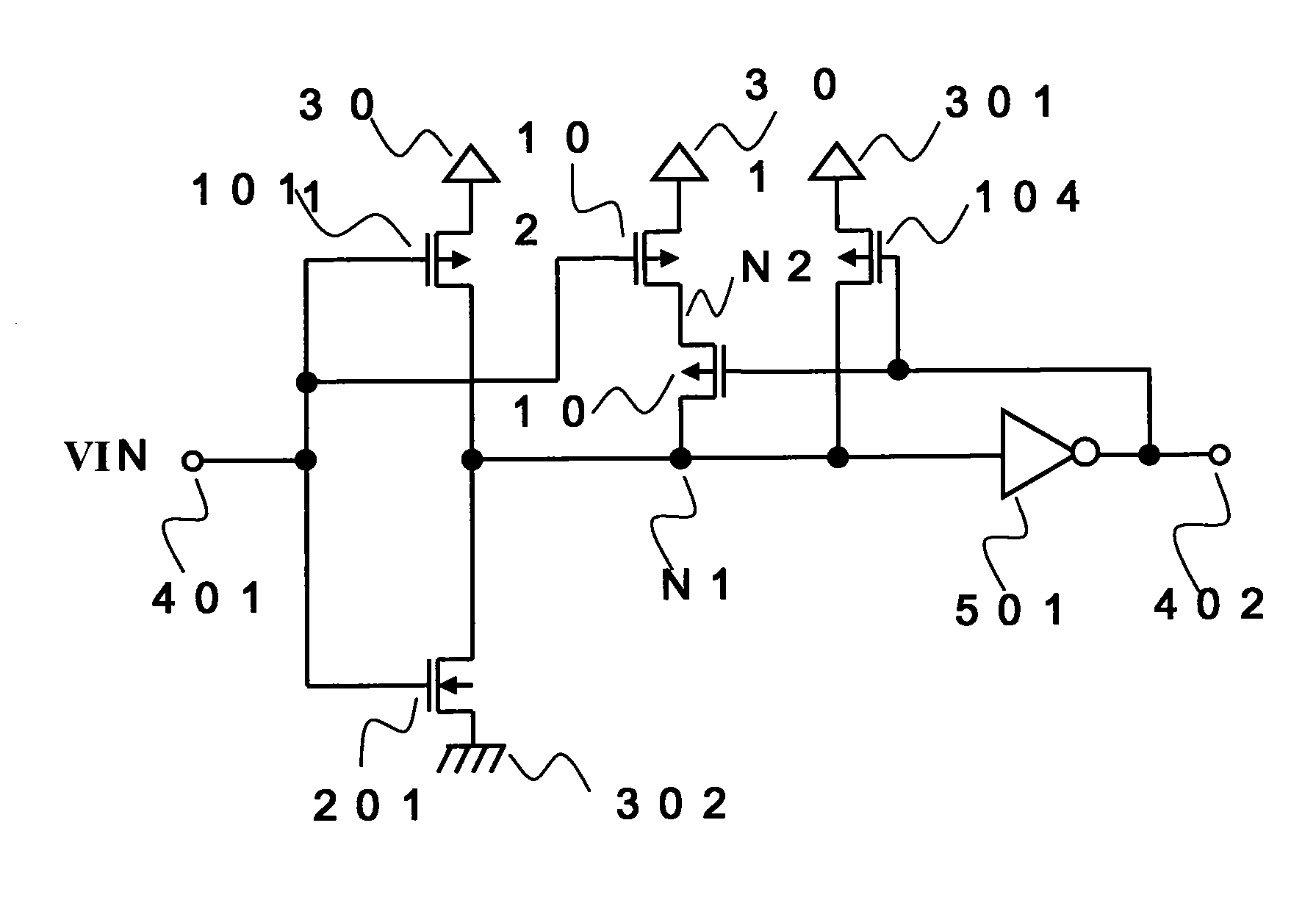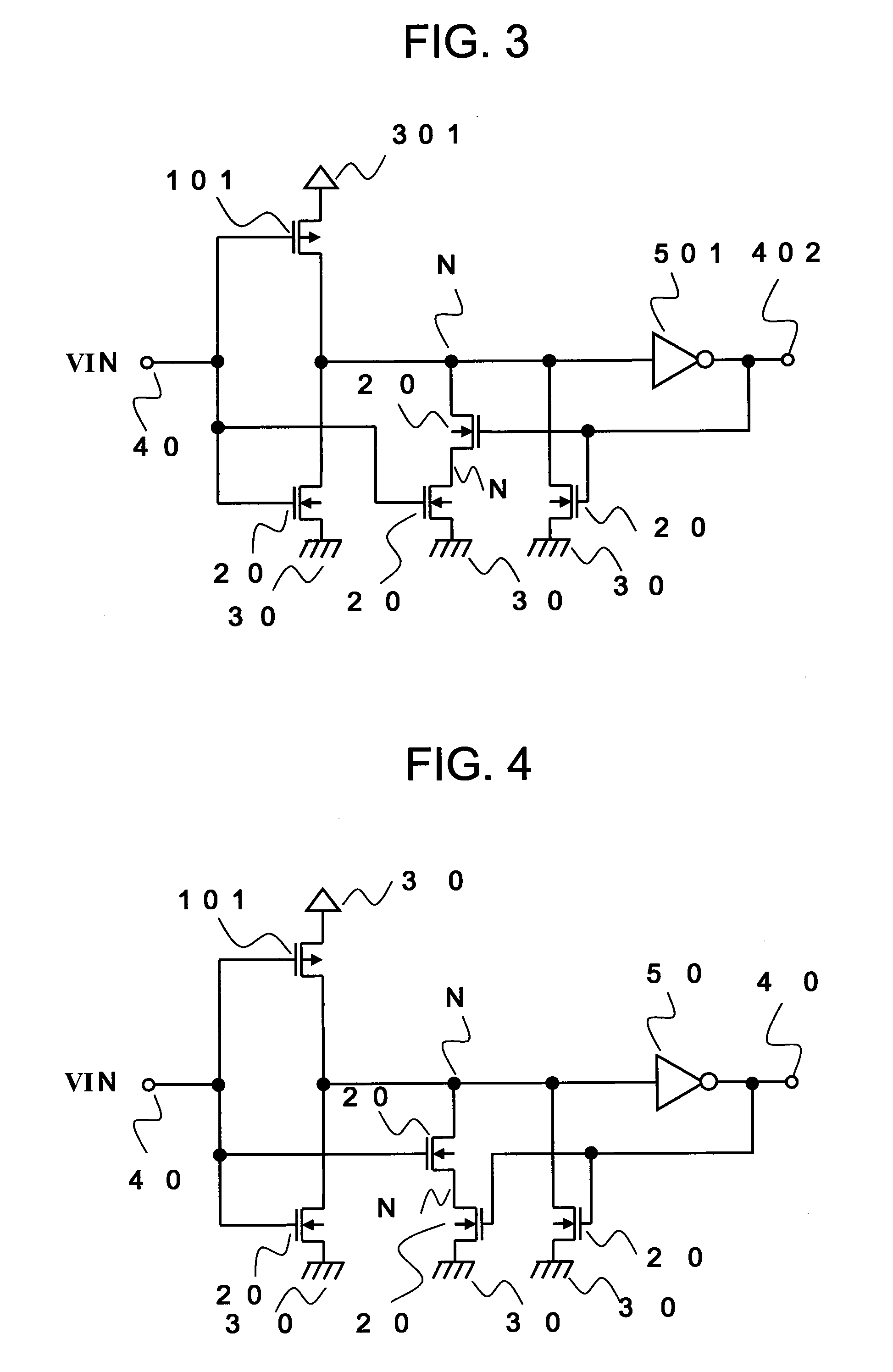Input circuit
a technology of input circuit and input signal, which is applied in the field of input circuit, can solve the problems of reducing response speed, power supply voltage dependence, and inability of input circuit to receive input signals with small swing width, so as to prevent the reduction of response speed, reduce the ratio of on-state resistance of pmos transistor to on-state resistance of nmos transistor, and increase the hysteresis voltage
- Summary
- Abstract
- Description
- Claims
- Application Information
AI Technical Summary
Benefits of technology
Problems solved by technology
Method used
Image
Examples
first embodiment
[0034]FIG. 1 is an input circuit having hysteresis characteristics according to a first embodiment of the present invention.
[0035]The input circuit having hysteresis characteristics according to the first embodiment includes PMOS transistors 101 to 104, an NMOS transistor 201, an inverter 501, a first power source 301 (hereinafter referred to as VDD), a second power source 302 (hereinafter referred to as VSS), the voltage of which is lower than that of the first power source 301, an input terminal 401, and an output terminal 402.
[0036]The PMOS transistors 101, 102, and 104 each have a source connected to VDD, while the NMOS transistor 201 has a source connected to VSS. The PMOS transistor 101 and the NMOS transistor 201 each have a gate connected to the input terminal 401 and a drain connected to a node N1. The inverter 501 has an input connected to the node N1 and an output connected to the output terminal 402. The PMOS transistor 102 has a gate connected to the input terminal 401 ...
second embodiment
[0045]FIG. 2 is an input circuit having hysteresis characteristics according to a second embodiment of the present invention.
[0046]The input circuit having hysteresis characteristics according to the second embodiment includes PMOS transistors 101 to 104, an NMOS transistor 201, an inverter 501, a first power source 301 (hereinafter referred to as VDD), a second power source 302 (hereinafter referred to as VSS), the voltage of which is lower than that of the first power source 301, an input terminal 401, and an output terminal 402. The second embodiment is different from the first embodiment in the following points. The PMOS transistor 102 has a drain connected to a node N1 and a source connected to a node N2. The PMOS transistor 103 as the interrupting means has a drain connected to the node N2 and a source connected to VDD.
[0047]Next, an operation of the input circuit having hysteresis characteristics according to the second embodiment is described.
[0048]As compared with the first...
third embodiment
[0050]FIG. 3 is an input circuit having hysteresis characteristics according to a third embodiment of the present invention.
[0051]The input circuit having hysteresis characteristics according to the third embodiment includes NMOS transistors 201 to 204, a PMOS transistor 101, an inverter 501, a first power source 301 (hereinafter referred to as VDD), a second power source 302 (hereinafter referred to as VSS), the voltage of which is lower than that of the first power source 301, an input terminal 401, and an output terminal 402.
[0052]The NMOS transistors 201, 202, and 204 each have a source connected to VSS, while the PMOS transistor 101 has a source connected to VDD. The PMOS transistor 101 and the NMOS transistor 201 each have a gate connected to the input terminal 401 and a drain connected to a node N1. The inverter 501 has an input connected to the node N1 and an output connected to the output terminal 402. The NMOS transistor 202 has a gate connected to the input terminal 401 a...
PUM
 Login to View More
Login to View More Abstract
Description
Claims
Application Information
 Login to View More
Login to View More - R&D
- Intellectual Property
- Life Sciences
- Materials
- Tech Scout
- Unparalleled Data Quality
- Higher Quality Content
- 60% Fewer Hallucinations
Browse by: Latest US Patents, China's latest patents, Technical Efficacy Thesaurus, Application Domain, Technology Topic, Popular Technical Reports.
© 2025 PatSnap. All rights reserved.Legal|Privacy policy|Modern Slavery Act Transparency Statement|Sitemap|About US| Contact US: help@patsnap.com



